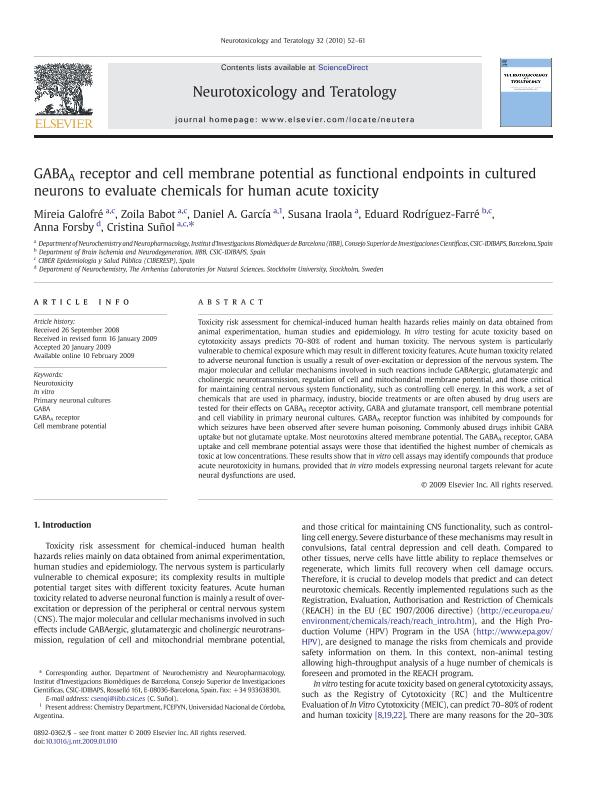Artículo
GABAA receptor and cell membrane potential as functional endpoints in cultured neurons to evaluate chemicals for human acute toxicity
Galofré, Mireia; Babot, Zoila; Garcia, Daniel Asmed ; Iraola, Susana; Rodriguez Farré, Eduard; Forsby, Anna; Suñol, Cristina
; Iraola, Susana; Rodriguez Farré, Eduard; Forsby, Anna; Suñol, Cristina
 ; Iraola, Susana; Rodriguez Farré, Eduard; Forsby, Anna; Suñol, Cristina
; Iraola, Susana; Rodriguez Farré, Eduard; Forsby, Anna; Suñol, Cristina
Fecha de publicación:
02/2010
Editorial:
Pergamon-Elsevier Science Ltd
Revista:
Neurotoxicology and Teratology
ISSN:
0892-0362
Idioma:
Inglés
Tipo de recurso:
Artículo publicado
Clasificación temática:
Resumen
Toxicity risk assessment for chemical-induced human health hazards relies mainly on data obtained from animal experimentation, human studies and epidemiology. In vitro testing for acute toxicity based on cytotoxicity assays predicts 70-80% of rodent and human toxicity. The nervous system is particularly vulnerable to chemical exposure which may result in different toxicity features. Acute human toxicity related to adverse neuronal function is usually a result of over-excitation or depression of the nervous system. The major molecular and cellular mechanisms involved in such reactions include GABAergic, glutamatergic and cholinergic neurotransmission, regulation of cell and mitochondrial membrane potential, and those critical for maintaining central nervous system functionality, such as controlling cell energy. In this work, a set of chemicals that are used in pharmacy, industry, biocide treatments or are often abused by drug users are tested for their effects on GABAA receptor activity, GABA and glutamate transport, cell membrane potential and cell viability in primary neuronal cultures. GABAA receptor function was inhibited by compounds for which seizures have been observed after severe human poisoning. Commonly abused drugs inhibit GABA uptake but not glutamate uptake. Most neurotoxins altered membrane potential. The GABAA receptor, GABA uptake and cell membrane potential assays were those that identified the highest number of chemicals as toxic at low concentrations. These results show that in vitro cell assays may identify compounds that produce acute neurotoxicity in humans, provided that in vitro models expressing neuronal targets relevant for acute neural dysfunctions are used.
Archivos asociados
Licencia
Identificadores
Colecciones
Articulos(IIBYT)
Articulos de INSTITUTO DE INVESTIGACIONES BIOLOGICAS Y TECNOLOGICAS
Articulos de INSTITUTO DE INVESTIGACIONES BIOLOGICAS Y TECNOLOGICAS
Citación
Galofré, Mireia; Babot, Zoila; Garcia, Daniel Asmed; Iraola, Susana; Rodriguez Farré, Eduard; et al.; GABAA receptor and cell membrane potential as functional endpoints in cultured neurons to evaluate chemicals for human acute toxicity; Pergamon-Elsevier Science Ltd; Neurotoxicology and Teratology; 32; 1; 2-2010; 52-61
Compartir
Altmétricas



